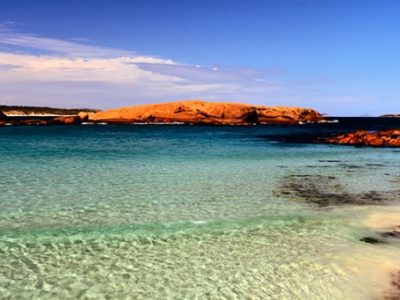Trip to the Southwest Coast of WA

Last week I had a most enjoyable visit to Perth and the southwest corner of WA. The reason for the trip was an invite to present the annual Joe Gentilli public lecture at the University of Western Australia. Joe was involved in the establishment of Geography at UWA. He was a pre-war refugee from fascist Italy and published extensively on climatology. My wife and I spent a wonderful week in Perth visiting friends, meeting the staff in Geography and travelling inland into the wheat belt besides wandering down the coast to Cape Naturaliste. It was great to catch up with our energetic ACS convenor in WA, Jo Ludbrook, who made arrangements for us to see the native flower display and to meet local folk interested in coastal issues.
Let me say something of the coastal setting in the SW of WA. I always get excited flying into Perth over the Darling Scarp. This is one of Earth’s great structural features seen from space. Ancient rocks stand out on the scarp as it dips down to the coastal plain. Perth sits on a mixture of Pliocene and Quaternary coastal sediments. What is fascinating is the contrast between the silica rich inner deposits and the cemented carbonate rich dune sands (Tamala Limestone) of the outer and hence younger coastal plain. Broad inter-dune depressions separate ridges with shallow lakes in this area. The Swan River slices through the plain opening into the majestic Swan estuary that reaches the sea at Fremantle. This is another example of an ”emerged” coastal plain with higher stands of the sea to the east descending to the west. It contrasts with the subsiding topography of the east Australian coast as discussed in my blog on the Neogene. Much of Perth’s water supply comes from bores in the coastal sediments—somewhere I read about 170000 bores!
It was great to go back to Mandurah. Last year ACS assisted in the arrangements for the 2014 Coast to Coast conference. Again I wish to thank Garry Middle and his team for all the great work in running this conference. I had the chance to look further at the by-passing system sending sand across the trained mouth of the estuary to the beach on the north side. Jo Ludbrook arranged for us to meet Paddi Creevey, the former Mayor of Mandurah who served with me on the previous federal government’s Coast and Climate Change Council. She is highly respected for her work in the area. Jo had organised a community meeting through her work with the Peron Naturaliste Partnership (PNP) and as ACS representative in WA. The meeting was well attended in the PNP “shed” with folk from state and local governments, and community members. It was also attended by 20 year 8 high school students. Jo chaired the meeting. There were three speakers: Nick Carroll of the local council who spoke on beach management including the by-passing project; Blair Darvill a project officer for CoastSWaP on coastal management practices; and myself. I loved the opportunity to speak to the students on their future as carers of the coast now and into the future as their lives unfold into periods of climate change in 2050 and 2070—told them to expect a few grey hairs along the way!
We travelled down to Cape Naturaliste to visit the beaches but especially to see the wild flowers and landforms of the Cape. Here cemented dune sands overly ancient uplifted rocks defined by the Dunsborough fault. Now I can see why this is an area that is regarded as a biodiversity hot spot of global significance. We just caught the spring bloom. Over 2000 plant species occur in this region. It was wonderful to see how different species crowd into each other and form a heath of magnificent proportions on the summit of the Cape. Elsewhere we were able to see beautiful small orchids of varying types. We are very grateful to Jo and her friends for the opportunity to see a coastal ecology such as this.
Finally just a few words about WA coastal management. I thought NSW was complex! However, several folk kindly tried to explain the system—took a whiteboard of some size to get there! But what is impressive is how the PNP has evolved, the interest in using the sediment compartments approach, the work of the Damara team as a consulting group working from geomorphic first principles, and the enthusiastic researchers in different universities.
One sad note: Lindsay Collins from Curtin University, passed away the week before I arrived. He led the field trip I went on last year at C2C. He was a top class coastal geologist and we will miss him.
– words by Prof. Bruce Thom


 Neogene and Coasts
Neogene and Coasts